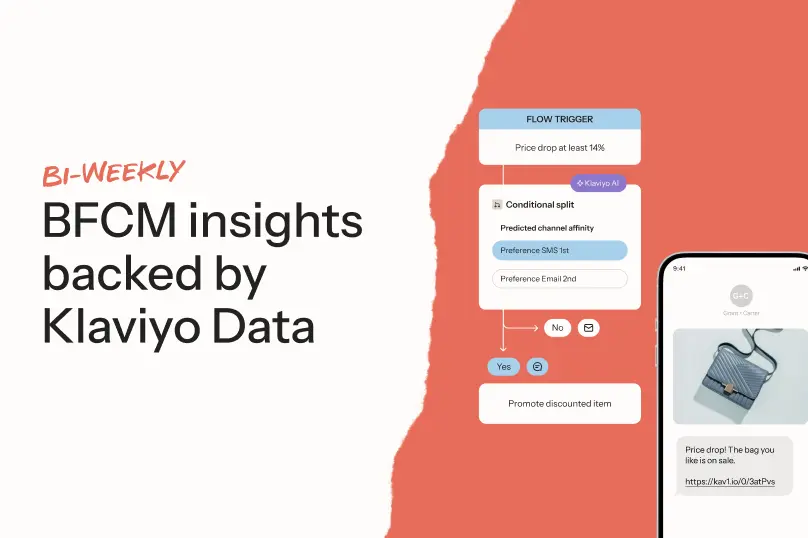5 marketing attribution challenges that are holding your B2C business back—and how to solve them
You can have the best-performing campaign of the quarter and still struggle to explain why it worked.
Marketing attribution, in theory, should be the key to understanding what drives results. But in practice, it’s often a patchwork of disconnected tools and half-complete data.
Most teams aren’t short on effort or ideas, but they are short on visibility. One platform shows email clicks, another tracks paid ads, and a third handles text message marketing. But none of them offer a full picture of the customer journey, let alone tie it back to revenue in a meaningful way.
“At a high level, a lot of today’s brands are operating in a very tough, lean environment,” says Elcee Vargas, lead product marketing manager at Klaviyo. “Acquisition costs have been rising for a while and reaching peak levels, while the return isn’t quite there and consumer confidence is more unpredictable.”
“Teams are doing a lot more with fewer resources,” Vargas adds. “Compared to 2023, there is a shift from very scrappy, high-velocity, high-testing environments to becoming more intentional and focusing on strategies that drive ROI.”
Here, we unpack 5 of the most common attribution challenges modern marketing teams face, especially those juggling multiple channels with limited resources. We explore why these problems persist, how they impact your ability to make smart decisions, and what it actually looks like to fix them.
Challenge 1: Fragmented data across channels
Most marketers are juggling a messy tech stack. One platform for email, another for text messages, and yet another for reviews. Maybe even a fourth for pop-ups or customer service. Each of these tools holds a sliver of the customer journey, but none of them tell the full story.
And that’s a problem.
When your data is scattered across 6–15 different sources, you don’t actually know what’s driving results. It might look like a campaign has flopped until you realize conversions happened via text, not email. Or you might find you’re spending more on paid ads than you should, because your organic channels aren’t getting credit where it’s due.
Even when you do have visibility into your fragmented data, it’s often trapped inside individual channel dashboards. You’re getting performance metrics from each tool, such as opens from your email platform, conversions from SMS, and impressions from ads, but you’re not seeing how these touchpoints work together to move customers from first click to purchase.
What happens is you’re stuck piecing together fragmented reports, trying to make sense of which channels are actually moving the needle and how they work together. Did that cart recovery text message convert someone who first saw your Instagram ad? Did a welcome email series help nudge someone toward buying from a retargeting campaign?
Attribution doesn’t work when your tools aren’t talking to each other. Siloed data leads to gaps in your reporting, incomplete insights, and frustratingly slow personalization.
The fix: Consolidating your tech stack to create a central source of truth
“Teams say their stack is ‘well integrated,’ but they also cite data accuracy and silos as top challenges,” Vargas says. “This is the perception vs. reality gap. APIs don’t solve everything—true integration requires a shared data model and centralized visibility. How quickly you can operate on this data is a key point of success.”
When your email, SMS, reviews, WhatsApp, mobile app notifications, and segmentation all live in one place, you get a clear, real-time view of every customer touchpoint. Every interaction updates in real time, feeding into a single timeline that shows exactly who did what, when, and where.
That means you can:
- See the full customer journey at a glance.
- Attribute revenue accurately across channels.
- Make faster, more informed decisions.
Challenge 2: Over-reliance on last-click attribution
Last-click attribution is the default for a reason: it’s easy. But in real life, customer journeys aren’t neat or linear. They look more like this: TikTok → Instagram → Email → Browse website → Abandon cart → Text message → Purchase.
If you’re only giving credit to the last touch (in this case, the text), you’re ignoring all the effort that went into getting the customer to click on that text in the first place.
That’s a big problem, especially when you’re investing in top-of-funnel and nurture channels like influencer campaigns, organic social, or automated email journeys like welcome series and abandoned cart flows. You might assume they’re not working, when in reality, they’re doing a lot of heavy lifting behind the scenes.
The fix: Omnichannel, linear multi-touch attribution
Omnichannel, linear multi-touch attribution is a way of tracking all the marketing touchpoints a customer interacts with before making a purchase. Instead of giving 100% of the credit to the last thing someone clicked on, it looks at every step along the way.
From the first ad someone saw to the emails they opened, omnichannel, linear multi-touch attribution maps out the full customer journey and shows how each channel, campaign, and interaction contributed to the final sale.
This kind of model is especially useful for modern B2C and ecommerce brands, where a single purchase might be influenced by everything from a TikTok video to an abandoned cart email to a well-timed text message. With omnichannel, linear multi-touch attribution, you can see how all those touchpoints work together, not just which one got the customer over the line.
Challenge 3: Difficulty proving ROI to stakeholders
Marketers today are expected to do more with less: more campaigns, more channels, more personalization, with tighter budgets and higher expectations. But when your attribution is fuzzy (or nonexistent), it’s nearly impossible to show the real impact of your efforts, especially in newer or harder-to-measure channels like influencer campaigns.
And when you can’t prove what’s driving revenue, everything starts to look like a cost. That makes it tough to secure budget, experiment with new strategies, or double down on what’s actually working.
The fix: Attribution that ties to revenue
If you want leadership to invest in marketing, you need more than vanity metrics. Opens, clicks, and impressions might tell part of the story, but they don’t prove business impact.
What actually moves the needle is being able to show that a specific email flow drove $12,000 in revenue last month, or that a recent WhatsApp campaign led to a 20% increase in repeat purchases.
That level of clarity comes from marketing and advertising attribution that’s deeply integrated into your marketing stack. Every send, click, segment, and touchpoint is automatically tracked and tied back to real outcomes like purchases, customer lifetime value, or subscription upgrades.
For example, instead of just seeing that someone clicked a product link in an email, you can see that:
- They later made a purchase worth $85.
- They were part of a high-value segment (e.g., VIP repeat buyers).
- That email campaign contributed 25% of the total revenue for the month.
Challenge 4: Legacy systems that can’t keep up
Most legacy marketing platforms weren’t built for the complexity of modern B2C. They were designed for simpler times, when email was the primary channel, customer journeys were linear, and batch-and-blast campaigns still worked.
But today’s B2C landscape is far more complex. Shoppers move between devices, channels, and touchpoints in seconds. They expect personalization, real-time relevance, and a seamless experience whether they’re opening an email, clicking a paid ad, chatting on WhatsApp, or browsing in your app.
Wrangling all of this can get expensive. Just ask Helen of Troy, an umbrella company that designs, develops, and markets houseware, health, and home products across multiple brands. After consolidating their email, SMS, and CDP under one roof, they reduced their total cost of ownership by 40%.
The fix: A modern platform built for B2C growth
Modern B2C brands need more than just a place to send emails. They need a platform that brings everything together in one place, including customer data, messaging channels, and revenue insights.
That looks like:
- Real-time customer profiles that automatically update with every action so you always know exactly where someone is in their journey
- Built-in automation that connects signals with actions, like sending a follow-up text message when someone abandons a cart, or suppressing email sends when someone just purchased via WhatsApp
- Dynamic segments that stay up to date, pulling in customers based on live behavior
- Attribution reporting tied directly to revenue, so you can see exactly how much each campaign, channel, or flow drove in sales
- One platform for all your owned channels, so your email, SMS, and mobile app messages aren’t operating in silos
With this kind of set-up, you can launch faster, personalize deeper, and prove the ROI of every touchpoint.
Challenge 5: Sophisticated strategies but slow execution
This one is less specific to attribution and more of a marketing challenge, period: as you grow, your marketing strategies naturally become more complex. You’re layering on personalization, building out cross-channel journeys, and experimenting with new channels.
On paper, it’s exciting. In practice, it can be painfully slow.
That’s because many of the tools that promise to support these advanced use cases weren’t actually built for execution. Yes, they were built to manage complex data, which sounds great…until you try to activate that data in real time.
Suddenly, segmentation becomes a developer’s job. Want to build a new journey? Hope you’ve got budget for agency support.
It’s the kind of set-up that eats up time, money, and momentum, and—ironically—keeps you from executing the very strategies those tools claimed to support.
The fix: Tech that empowers marketing teams, not just data teams
Today’s best marketing and analytics platforms let marketers access historical data in real time, build advanced segments on the fly, and connect up their tech stack. This leads to:
- Faster testing
- Smarter targeting
- More room for your team to actually do the work that drives growth
Attribution doesn’t have to be this hard
Attribution is supposed to be complex. You’re trying to measure how every campaign, click, and channel contributes to revenue across a nonlinear customer journey. It’s no small feat.
But it shouldn’t feel impossible.
The truth is, most attribution challenges come down to one thing: fragmented systems. When your data lives in silos, your customer view is incomplete—and your reporting, targeting, and decision-making all suffer as a result.
Solving attribution starts with unifying your marketing, your data, and your customer touchpoints. That means working from a shared source of truth, where every interaction feeds into a real-time customer profile that updates automatically.
That’s exactly what a B2C CRM like Klaviyo is built to do:
- Bring all your owned channels into one place.
- Let you build dynamic, behavior-based segments instantly.
- Tie every campaign and flow to revenue with baked-in attribution.
- Power personalization with real-time zero- and first-party data.
Klaviyo, the CRM built for B2C, approaches this by centralizing customer data from email, SMS, WhatsApp, forms, and mobile app messaging into a single platform.
Every customer interaction updates a unified profile in real time, which means marketers can segment more precisely, personalize with current behavior in mind, and report on campaign performance in a way that ties directly to revenue—without relying on third-party tools or manual work.

Related content

Learn 5 ways to turn new holiday shoppers into repeat buyers using personalization, seamless returns, targeted outreach, and AI-driven customer experiences.

Learn what to include in your photography style guide to create consistent, on-brand visuals across your B2C marketing channels.

Shopping is about to hit its peak season. But this year’s surge will look different from those before it. Instead of impulsive buying sprees, shoppers are entering the holidays with a more deliberate mindset.